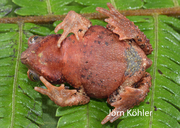|
Rhinella yanachaga Lehr, Pramuk, Hedges & Córdova, 2007
| family: Bufonidae genus: Rhinella |
| Species Description: Lehr E, Pramuk JB, Hedges SB, Cordova JH 2007 A new species of arboreal Rhinella (Anura:Bufonidae) from Yanachaga-Chemillen National Park in central Peru. Zootaxa 1662:1-14 | |
 © 2025 Jörn Köhler (1 of 2) |
|
|
|
Description The head is slightly wider than long and dorsally flat. The snout protrudes laterally with a prominent vertical keel. Males have a pair of keratin-tipped tubercles on the snout. The canthus rostralis is distinct and in males, is covered with small tubercles, each with a keratinized tip. The loreal region is concave. Orbitotympanic and postorbital crests are distinct, and in males they are also tuberculate. The cranial skin is co-ossified with underlying cranial bones and in males, has many small, round, elevated tubercles with keratinized tips. Lips are rounded. The diameter of the tympanum is less than the width of the eye, and the tympanic annulus appears as a narrow rim covered by small tubercles. In males, the upper eyelid has conical keratin-tipped tubercles. Parotoid glands are ovoid when viewed dorsally and subtriangular when viewed dorsolaterally. The tongue is three times as long as wide. Forearm is long and slim in females but hypertrophied in males. Finger length increases in order from I,II,IV,III with fleshy webbing and discs on tips of digits. Males also possess small keratinous spines on fingers I and II. Subarticular tubercles are ovoid; supernumerary tubercles are 1/4 as large as subarticular tubercles; and palmar tubercles are large and round. Lower limbs are long, but the tibia is shorter than the foot length. Adpressed toes increase in length from I,II,III,V,IV and exhibit fleshy webbing. The tarsal fold is lacking. The foot has ovoid subarticular tubercles. The cloacal opening is protuberant (Lehr et al. 2007).
In life, field notes describe a male specimen (not the holotype, for which coloration in life is unknown) as having tuberculate skin, dark brown dorsally with small irregular green spots and blotches, which were more concentrated in number just above the dorsolateral row of tubercles. The sides, below the dorsolateral tubercle row, were reddish brown. Upper lip was reddish brown with green flecking. Venter was orange brown, with small green spots on the ventral surface of the chin, darker brown flecks on the belly, and brown to black markings on the ventral surfaces of the limbs. The male had an olive brown iris. A female specimen had smooth skin and was tan with light brown markings and a narrow yellowish middorsal stripe bordered by small black markings. The female had dark brown sides with a greenish spot posterior to the tympanum. The venter had brown mottling (reddish brown on the chest) and a faint yellow midventral line. Iris was bronze in the female. In preservative, the dorsum is brown, parotoids brownish orange, and tympanum dark brown. A thin tan stripe extends from snout to cloaca, broad tan stripes on side of flanks extend from parotoids to groin, and broad brown stipes extend behind tympanum to inguinal region. Throat, chest, and the venter all look tan with few grayish-brown spots. Ventral surfaces of hands and feet are grey (Lehr et al. 2007). Bufo yanachaga is sexually dimorphic in morphology as well as coloration. Females are slightly larger in size. The dorsal skin of males is spinose, but the skin of females is smooth and lacks keratin tubercles. All males have vocal slits, nuptial pads, and hypertrophied arms, whereas female arms are slim. The cloaca is more protruding in males than in females, with the cloacal opening pointing ventrally in males and laterally in females (Lehr et al. 2007). Distribution and Habitat Country distribution from AmphibiaWeb's database: Peru
Life History, Abundance, Activity, and Special Behaviors One adult male was found underneath a layer of moss and dirt, 10-20 cm below ground, and another was perched on the top of leaves about 50 cm above ground. Other specimens were found in trees (Lehr et al. 2007). The difference in cloacal morphology between males (more protuberant, ventrally oriented) and females (less protuberant, laterally oriented) may indicate that this species has internal fertilization, as is the case for several other bufonid species. The role of hypertrophied arms in males is not known, but may serve a function in male-male combat or to aid gripping the female during amplexus (Lehr et al. 2007). One preserved female specimen contained 136 unpigmented eggs, which appeared pale orange in preservative (Lehr et al. 2007). Syntopic species are Phrynopus bracki, Pristimantis mendax, and Pristimantis sagittulus. Trends and Threats Comments
References
Lehr., E., Pramuk, J. B., Hedges, S. B., and Cordova, J. H. (2007). ''A new species of arboreal Rhinella (Anura: Bufoniade) from Yanachaga-Chemillen National Park in central Peru.'' Zootaxa, 1662, 1-14. Originally submitted by: Henry Zhu (first posted 2009-02-03) Edited by: Kellie Whittaker (2009-03-27) Species Account Citation: AmphibiaWeb 2009 Rhinella yanachaga <https://amphibiaweb.org/species/7019> University of California, Berkeley, CA, USA. Accessed Jun 15, 2025.
Feedback or comments about this page.
Citation: AmphibiaWeb. 2025. <https://amphibiaweb.org> University of California, Berkeley, CA, USA. Accessed 15 Jun 2025. AmphibiaWeb's policy on data use. |


 Map of Life
Map of Life